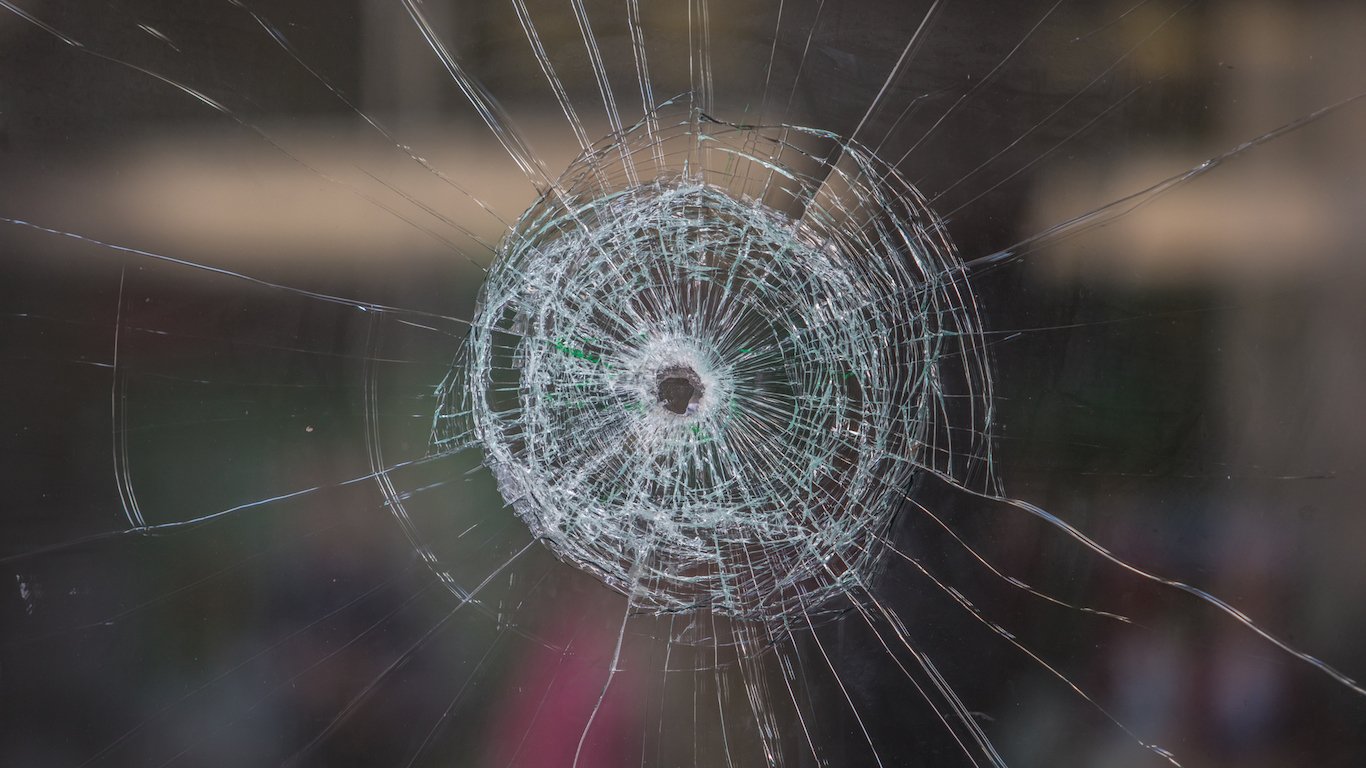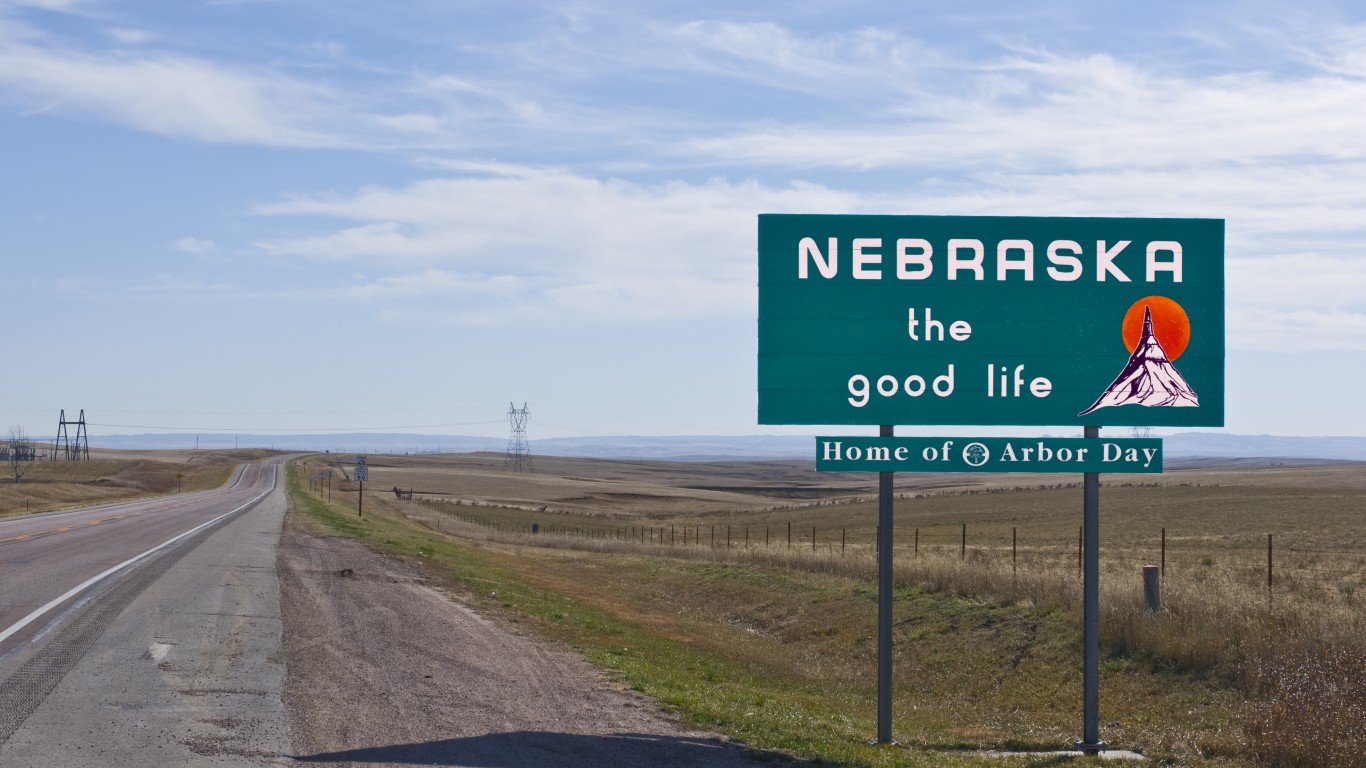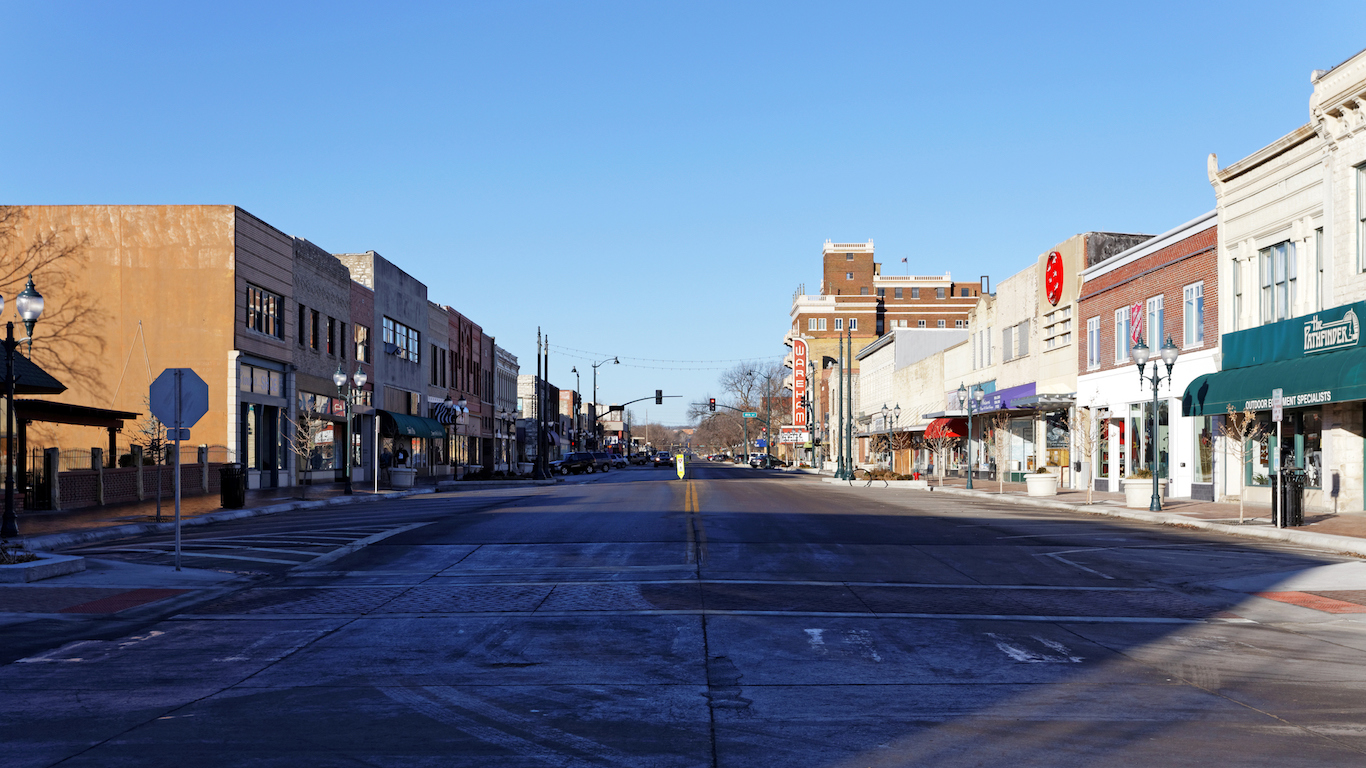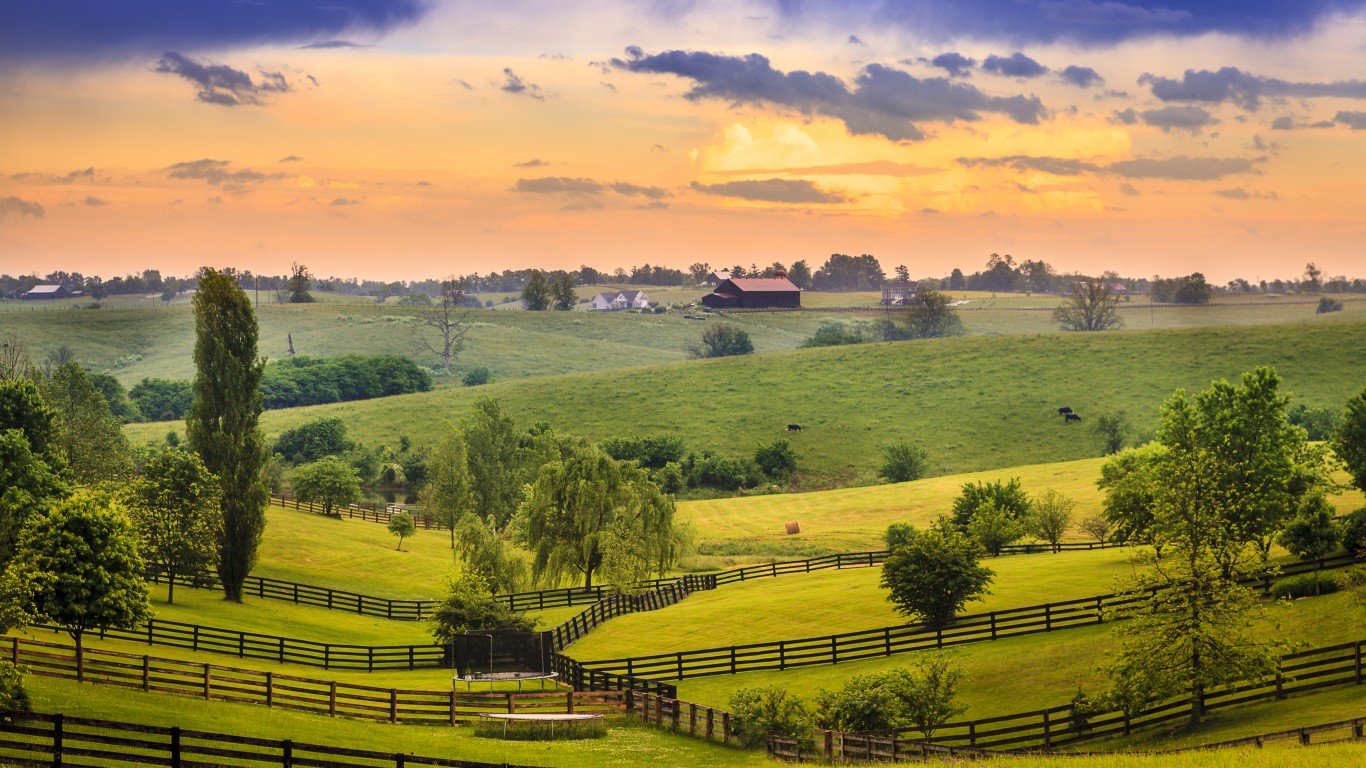

Three of the five deadliest mass shootings in U.S. history occurred within the last three years. In light of the recent surge, it can be easy to assume that violence is a growing problem in the United States.
However, by several measures, the United States is actually less violent than it has been in recent decades. Since peaking in 1991, the violent crime rate has fallen to lows not seen in nearly half a century. Similarly, the U.S. murder rate is almost half of what it was at its peak in 1980.
Still, crime rates are only one measure of violence in American society. According to the think tank Institute for Economics and Peace, gun ownership and incarceration are good indicators the prevalence of violence. If the United States was a more peaceful place, there would be less need for handguns — which are typically purchased for personal protection — and there would be less need for the state to use violence against citizens in the form of arrest and incarceration.
24/7 Wall St. identified the most and least violent states in the country based on an index of each state’s murder rate, its violent crime rate excluding murder, small arms ownership, and incarceration rates.
More violent states are often home to a less educated population that tends to face greater economic hardship. Geographically, many of the most violent states are in the South, while the least violent states are overwhelmingly in the Northeast.
Click here to see the America’s most and least violent states.
Click here to see our detailed findings and methodology.

50. Maine
> Violent crime rate: 123.8 per 100,000 (the lowest)
> Murder rate: 1.5 per 100,000 (2nd lowest)
> Median household income: $53,079 (19th lowest)
> May unemployment rate: 3.0% (17th lowest)
New England states comprise six of the country’s seven least violent states. Of them, Maine is the least violent in both the region and the country. There were 124 violent crimes in Maine for every 100,000 residents in 2016, the lowest violent crime rate of any state. Additionally, just 137 people are incarcerated in a Maine state correctional facility for every 100,000 residents, the lowest incarceration rate in the country. Nationwide, aggravated assault is the most common violent crime, reported at a rate of 249 incidents for every 100,000 Americans. In Maine, there were 71 cases of aggravated assault for every 100,000 residents, the lowest aggravated assault rate of any state.
As is often the case in states with low incarceration and violent crime rates, Maine’s economy is relatively healthy. Just 3.0% of the labor force are out of work, well below the May 2018 unemployment rate of 3.8% nationwide. Additionally, just 12.5% of state residents live below the poverty line compared to 14.0% of Americans nationwide.
[in-text-ad]

49. New Hampshire
> Violent crime rate: 197.6 per 100,000 (3rd lowest)
> Murder rate: 1.3 per 100,000 (the lowest)
> Median household income: $70,936 (7th highest)
> May unemployment rate: 2.6% (9th lowest)
While nationwide there were 386 violent crimes per 100,000 Americans in 2016, in New Hampshire there were 198 incidents reported per 100,000 residents, the third lowest violent crime rate of any state. There were 17 murders reported in the state that year, equal to 1.3 cases per 100,000 residents. This is the lowest murder rate of any state.
Wealthier areas with better-educated population tend to have lower violent crime rates. The typical household in New Hampshire earns $70,936 a year, the seventh highest of any state and approximately $13,000 more than the national median. Some 92.3% of New Hampshire adults have a high school diploma, the seventh largest share nationwide.

48. Hawaii
> Violent crime rate: 309.2 per 100,000 (21st lowest)
> Murder rate: 2.5 per 100,000 (10th lowest)
> Median household income: $74,511 (5th highest)
> May unemployment rate: 2.0% (the lowest)
Hawaii is the only state outside of the New England region to rank among the seven least violent states. While Hawaii’s violent crime rate of 309 reported incidents per 100,000 residents is not as low as it is in some parts of the country, it is markedly better than the national violent crime rate of 386 incidents per 100,000 people.
Gun violence in particular is especially rare in Hawaii. Just 19.7% of all suicides in the state between 2012 and 2016 were carried out with a firearm, the smallest share of any state and less than half the comparable national share of 50.6%. Similarly, the state’s firearm murder rate of 0.7 incidents per 100,000 people is the lowest of any state and a fraction of the nationwide rate of 3.8 per 100,000.

47. Massachusetts
> Violent crime rate: 376.9 per 100,000 (23rd highest)
> Murder rate: 2.0 per 100,000 (5th lowest)
> Median household income: $75,297 (4th highest)
> May unemployment rate: 3.3% (21st lowest)
Like every other state in New England, Massachusetts is one of the least violent states in the country. While there were 377 violent crimes reported per 100,000 Massachusetts residents in 2016 — roughly in line with the national violent crime rate of 386 incidents per 100,000 Americans — the state has one of the lowest murder rates in the country
There were 134 murders reported in Massachusetts in 2016, or 2.0 per 100,000 state residents. The state’s murder rate is tied with North Dakota for the fourth lowest in the country. Massachusetts has some of the strictest gun laws in the United States, and handgun ownership is relatively uncommon. Firearms are a factor in just 21.4% of all suicides — the second smallest share of any state.
[in-text-ad-2]

46. Vermont
> Violent crime rate: 158.3 per 100,000 (2nd lowest)
> Murder rate: 2.2 per 100,000 (7th lowest)
> Median household income: $57,677 (20th highest)
> May unemployment rate: 2.6% (9th lowest)
There were 158 incidents of violent crime in Vermont for every 100,000 residents in 2016, the second lowest violent crime rate in the country. Aggravated assault is the most common form of violent crime in the United States, and Vermont’s aggravated assault rate of 111 incidents per 100,000 residents is less than half the national rate. Similarly, Vermont’s murder rate of 2.2 homicides per 100,000 people is less than half the U.S. murder rate of 5.3 per 100,000.
Due in part to a low violent crime rate, Vermont’s incarceration rate is among the lowest in the nation. There are only 197 people in a Vermont state correctional facility for every 100,000 state residents, the fifth lowest incarceration rate of any state and less than half the U.S. rate.

45. Rhode Island
> Violent crime rate: 238.9 per 100,000 (8th lowest)
> Murder rate: 2.7 per 100,000 (13th lowest)
> Median household income: $60,596 (18th highest)
> May unemployment rate: 3.8% (14th highest)
While there were 386 violent crimes reported per 100,000 Americans in 2016, in Rhode Island there were 239 incidents per 100,000 residents. Like many states in the Northeast, Rhode Island has some of the strictest gun laws in the country. As evidenced by a low firearm suicide rate — a measure that is used to approximate handgun ownership — relatively few people in the state own handguns. Firearms are a factor in just 25.7% of all suicides in the state, the fourth smallest share nationwide. Rhode Island also has the fourth lowest incarceration rate of any state. For every 100,000 residents, there are 192 people in state correctional facilities. That is less than half the national incarceration rate of 450 inmates per 100,000 Americans.
[in-text-ad]

44. Connecticut
> Violent crime rate: 227.1 per 100,000 (5th lowest)
> Murder rate: 2.2 per 100,000 (7th lowest)
> Median household income: $73,433 (6th highest)
> May unemployment rate: 4.3% (6th highest)
Though it ranks as the most violent state in New England, Connecticut is far less violent than the nation as a whole. Connecticut has some of the strictest firearm laws in the country, including strict regulations on assault style weapons and permit requirements for carrying a handgun. Likely due in part to a restricted access to firearms, gun violence is relatively rare in Connecticut. There were 5 firearm-related deaths, including suicide, in the state for every 100,000 people from 2012 to 2016, less than half the national rate of 11 gun deaths per 100,000 over that time.
Violence in Connecticut is almost exclusively confined to the state’s metro areas. Over 94% of the 8,100 violent crimes in the state in 2016 were committed in a metropolitan area.

43. Minnesota
> Violent crime rate: 242.6 per 100,000 (9th lowest)
> Murder rate: 1.8 per 100,000 (3rd lowest)
> Median household income: $65,599 (13th highest)
> May unemployment rate: 2.5% (6th lowest)
Minnesota is the least violent state in the Midwest. There were 243 violent crimes reported in the state per 100,000 residents in 2016, far less than the national rate of 386 incidents per 100,000 Americans and the ninth lowest of any state. There were 101 murders reported in the state that year. Those 101 murders amount to 1.8 per 100,000 state residents, which is the third lowest homicide rate of any state.
Wealthy states with better-educated population and low unemployment are often the least violent. The typical Minnesota household earns $65,599 a year, about $8,000 more than the U.S. median. Some 92.9% of adults in Minnesota have a high school diploma, and just 2.5% of the workforce is unemployed, respectively the third largest and sixth smallest shares nationwide.

42. New Jersey
> Violent crime rate: 245.0 per 100,000 (12th lowest)
> Murder rate: 4.2 per 100,000 (23rd lowest)
> Median household income: $76,126 (3rd highest)
> May unemployment rate: 3.7% (17th highest)
New Jersey has some of the country’s strictest gun laws. These laws include restrictions on military style weapons and concealed carry as well as stringent background check requirements. Likely due in part to more restricted access, gun violence is relatively rare in the Garden State. About one in every four suicides in New Jersey were carried out with a firearm from 2012 through 2016 compared to half of all suicides nationwide. Overall, firearm deaths — including murder — are about half as common in New Jersey as they are nationwide.
New Jersey also incarcerates up a relatively small share of its population. For every 100,000 residents, the state sentenced 221 people to prison in 2016, less than half the U.S. incarceration rate of 450 per 100,000.
[in-text-ad-2]

41. North Dakota
> Violent crime rate: 251.1 per 100,000 (13th lowest)
> Murder rate: 2.0 per 100,000 (5th lowest)
> Median household income: $60,656 (17th highest)
> May unemployment rate: 2.2% (3rd lowest)
Since the early 2000’s, North Dakota experienced an oil production boom that led to higher incomes and lower unemployment throughout the state. While prosperity tends to coincide with reduced crime, violent crime rose sharply in North Dakota’s oil boomtowns over this period. The violent crime rate soared from 174 incidents per 100,000 North Dakota residents in 2006 to 251 violent crimes 100,000 residents in 2016, yet it remained below the national rate of 386 violent crimes per 100,000 Americans. In response to the spike in crime, the FBI opened in 2016 a fifth North Dakota field office in Williston, one of the state’s main oil boom centers.

40. Utah
> Violent crime rate: 242.8 per 100,000 (10th lowest)
> Murder rate: 2.4 per 100,000 (9th lowest)
> Median household income: $65,977 (11th highest)
> May unemployment rate: 2.8% (12th lowest)
Utah is the least violent state in the Western United States. There were 2.4 murders for every 100,000 state residents in 2016, less than half the murder rate nationwide of 5.3 per 100,000. The state’s overall violent crime rate — including homicides — of 243 incidents per 100,000 people is 10th lowest among states and well below the national rate of 386 per 100,000. Violence in Utah is primarily confined to cities. Some 90.5% of reported violent crimes in the state in 2016 were committed in metro areas.
States with low violent crime rates tend to have relatively high earning populations, and Utah is no exception. The typical household in the state earns $65,977 a year, about $8,400 more than the median income nationwide.
[in-text-ad]

39. Iowa
> Violent crime rate: 290.6 per 100,000 (16th lowest)
> Murder rate: 2.3 per 100,000 (8th lowest)
> Median household income: $56,247 (25th lowest)
> May unemployment rate: 2.2% (3rd lowest)
There were 71 murders and 1,148 robberies reported in Iowa in 2016, the fifth least of any state when adjusted for the population. In total, there were 291 violent crimes per 100,000 residents, far less than the national rate of 386 incidents per 100,000 Americans.
Iowa ranks among the least dangerous states in other measures of violence and safety. Firearms are a factor in 47.7% of all suicides in Iowa, less than the 50.6% national figure and among the smallest share of any state. Iowa is also in the minority of states that do not impose the death penalty, and it has one of the lowest incarceration rates nationwide. There are 286 prisoners incarcerated in Iowa state correctional facilities per 100,000 residents, far less than the national incarceration rate of 450 inmates per 100,000 Americans.

38. New York
> Violent crime rate: 376.2 per 100,000 (24th highest)
> Murder rate: 3.2 per 100,000 (17th lowest)
> Median household income: $62,909 (14th highest)
> May unemployment rate: 3.7% (17th highest)
New York’s violent crime rate of 376 incidents per 100,000 residents is only slightly below the the national rate of 386 per 100,000. However, the state’s homicide rate is relatively low. There were 3.2 murders for every 100,000 state residents in 2016, compared to 5.2 per 100,000 nationwide. Rates of firearm-related deaths, including suicide, are similarly low. There were 4.3 firearm-inflicted fatalities in New York for every 100,000 residents from 2012 to 2016, less than half the national rate of 11 per 100,000 over the same period.
The low firearm fatality rate may be attributable to strict gun laws in the state. New York heavily restricts concealed carry and military-style assault weapons. In New York City specifically, gun restrictions are among the toughest in the nation.

37. Nebraska
> Violent crime rate: 291.0 per 100,000 (17th lowest)
> Murder rate: 2.6 per 100,000 (11th lowest)
> Median household income: $56,927 (22nd highest)
> May unemployment rate: 2.8% (12th lowest)
There were 2.6 murders reported in Nebraska per 100,000 residents in 2016, less than half the national homicide rate of 5.3 murders per 100,000 Americans. Similarly, there were 49.6 robberies per 100,000 residents, also less than half the national rate of 102.8 per 100,000. In total, there were 291 violent crimes reported per 100,000 Nebraska residents in 2016, well below the national rate of 386 per 100,000.
The relatively low prevalence of violent crime in Nebraska is likely one reason behind the state’s low incarceration rate. While nationwide there are 450 inmates incarcerated in state correctional facilities per 100,000 Americans, in Nebraska there are 274 inmates per 100,000 residents.
[in-text-ad-2]

36. Washington
> Violent crime rate: 302.2 per 100,000 (19th lowest)
> Murder rate: 2.7 per 100,000 (13th lowest)
> Median household income: $67,106 (10th highest)
> May unemployment rate: 4.4% (5th highest)
The incidences of murder, robbery, and aggravated assault are all lower in Washington state than they are across the United States as a, while the incidence of rape is slightly higher. Still, the state’s violent crime rate of 302 incidents per 100,000 people is well below the national violent crime rate of 386 per 100,000. About 88% of all violent crimes and 85% of murders in Washington occurred in metropolitan areas in 2016.
While violence is relatively uncommon in Washington, other types of crime are more common. The state’s 2016 property crime rate of 3,494 incidents per 100,000 people is the second highest in the country. Property crimes include burglary and motor vehicle theft.

35. Oregon
> Violent crime rate: 264.6 per 100,000 (14th lowest)
> Murder rate: 2.8 per 100,000 (14th lowest)
> Median household income: $57,532 (21st highest)
> May unemployment rate: 3.5% (24th highest)
There were 113 murders, 1,721 rapes, 2,278 robberies, and 6,718 aggravated assaults reported in Oregon in 2016. Adjusted for the population, there were a total of 265 violent crimes per 100,000 residents, less than the national rate of 386 incidents per 100,000 residents. The lower incidence of violent crime is likely one factor contributing to the state’s low incarceration rate. While nationwide there are 450 inmates incarcerated in state correctional facilities per 100,000 Americans, in Oregon there are 367 inmates per 100,000 residents.
While states with less violent crime tend to be wealthier with a better educated population, Oregon’s median household income and college attainment rate are roughly in line with the nation as a whole. The typical household in the state earns $57,532 a year, and some 32.7% of adults have a bachelor’s degree, compared to $57,617 and 31.3% nationwide.
[in-text-ad]

34. Idaho
> Violent crime rate: 230.3 per 100,000 (6th lowest)
> Murder rate: 2.9 per 100,000 (15th lowest)
> Median household income: $51,807 (15th lowest)
> May unemployment rate: 2.5% (6th lowest)
Only five states have a lower violent crime rate than Idaho. There were 230 violent crimes in the state for every 100,000 residents in 2016 compared to 386 violent crimes per 100,000 Americans nationwide. Idaho had the second lowest robbery rate in 2016 with just 12.7 incidents per 100,000. As is the case nationwide, aggravated assaults are the most common form of violence in Idaho.
Idaho has some of the weakest gun laws in the country, and likely due in part to easy access, suicide by firearm is a problem in the state. There were 12 suicides involving firearms for every 100,000 Idaho residents from 2012 through 2016, the fourth highest rate of any state.Other firearm-related violence is relatively uncommon in Idaho, however, as there were 1.2 murders committed with a gun for every 100,000 residents from 2012 to 2016, less than half the comparable national rate.

33. Wyoming
> Violent crime rate: 244.2 per 100,000 (11th lowest)
> Murder rate: 3.4 per 100,000 (18th lowest)
> Median household income: $59,882 (19th highest)
> May unemployment rate: 3.8% (14th highest)
There were 20 murders, 205 rapes, 59 robberies, and 1,146 aggravated assaults reported in Wyoming in 2016. In total, there were 244 violent crimes per 100,000 residents, far less than the national rate of 386 incidents per 100,000 Americans.
While Wyoming is less violent than the country as a whole, gun violence is more common in the state than it is nationwide. Gun ownership is relatively unrestricted in Wyoming. Easily accessible, guns a common factor in suicides across the state. Guns are used in 62.6% of all suicides in Wyoming, far more than the national share of 50.6%.

32. Wisconsin
> Violent crime rate: 305.9 per 100,000 (20th lowest)
> Murder rate: 4.0 per 100,000 (22nd lowest)
> Median household income: $56,811 (24th highest)
> May unemployment rate: 2.6% (9th lowest)
Rates of the four sub-categories of violent crime — aggravated assault, robbery, rape, and homicide — are each lower in Wisconsin than they are nationwide. Overall, there were 306 violent crimes for every 100,000 people in the state in 2016, well below the national rate of 386 incidents per 100,000 people. Wisconsin also incarcerates a smaller share of its population than is typical nationwide, with 383 people sentenced to state prisons for every 100,000 residents.Nationwide, 450 people are in state prison per 100,000 Americans.
States with lower than typical violent crime and incarceration rates also tend to have relatively strong economies, and Wisconsin is no exception. Just 2.6% of the state’s labor force was unemployed as of May 2018, well below the 3.8% U.S. unemployment rate.
[in-text-ad-2]

31. Virginia
> Violent crime rate: 217.6 per 100,000 (4th lowest)
> Murder rate: 5.8 per 100,000 (20th highest)
> Median household income: $68,114 (8th highest)
> May unemployment rate: 2.9% (14th lowest)
There were just 217.6 violent crimes reported per 100,000 residents in Virginia in 2016, the fourth lowest violent crime rate of any state and far below the national rate of 386.3 incidents per 100,000 Americans. While violent crime — which consists of murder, rape, robbery, and aggravated assault — is less common in Virginia than it is nationwide, the state has a relatively high homicide rate. There were 484 murders in Virginia in 2016, or 5.8 per 100,000 people, more than the national homicide rate of 5.3 murders per 100,000 Americans.
Virginia also ranks worse than a majority of states in gun violence. Some 56.2% of all suicides in the state were carried out with a firearm, compared to the 50.6% national average.

30. Colorado
> Violent crime rate: 342.6 per 100,000 (23rd lowest)
> Murder rate: 3.7 per 100,000 (20th lowest)
> Median household income: $65,685 (12th highest)
> May unemployment rate: 2.4% (4th lowest)
Crime rates tend to be lower in better-educated populations. In Colorado, 39.9% of adults have a bachelor’s degree or higher, the second largest share of any state. Colorado is also less violent than most states. There were 343 violent crimes for every 100,000 people in the state in 2016, below the national rate of 386 violent crimes per 100,000 people. Additionally, though gun ownership is subject to less regulation in Colorado than in many other states, some forms of gun violence are relatively uncommon. For example, there were 2.3 homicides carried out with a firearm for every 100,000 state residents from 2012 through 2016 compared to 3.8 per 100,000 nationwide. However, suicide by firearm is more common in Colorado than it across the nation as a whole.
[in-text-ad]

29. South Dakota
> Violent crime rate: 418.4 per 100,000 (19th highest)
> Murder rate: 3.1 per 100,000 (16th lowest)
> Median household income: $54,467 (22nd lowest)
> May unemployment rate: 2.9% (14th lowest)
There were 27 murders, 509 rapes, 272 robberies, and 2,813 aggravated assaults reported in South Dakota in 2016. Adjusted for the population, there were 418 violent crimes per 100,000 residents in the state, more than the national violent crime rate of 386 incidents per 100,000 Americans.
In other measures of violence, South Dakota ranks towards the middle of all states. Firearms were a factor in 49.7% of all suicides in the state, compared to 50.6% nationwide. Additionally, some 440 in every 100,000 residents are incarcerated in a South Dakota state prison, roughly in line with the national incarceration rate of 450 state prison inmates per 100,000 Americans.

28. Kansas
> Violent crime rate: 380.4 per 100,000 (22nd highest)
> Murder rate: 3.8 per 100,000 (21st lowest)
> Median household income: $54,935 (23rd lowest)
> May unemployment rate: 3.3% (21st lowest)
Kansas’s violent crime rate of 380 incidents for every 100,000 people is in line with the national rate of 386 incidents per 100,000 people. In other ways, crime patterns in Kansas bear little resemblance to broader national patterns. For example, about 83% of all violent crimes in the United States are committed within metropolitan areas. In Kansas, however, only about half of all violent crimes occur in metro areas.
Property crime is also more common in Kansas than it is nationwide. There were 2,696 property crimes in the state — including burglary and motor vehicle theft — for every 100,000 people in 2016, more than in most states and higher than the national property crime rate of 2,451 per 100,000.

27. Montana
> Violent crime rate: 368.3 per 100,000 (25th lowest)
> Murder rate: 3.5 per 100,000 (19th lowest)
> Median household income: $50,027 (11th lowest)
> May unemployment rate: 3.0% (17th lowest)
Montana ranks near the middle of all states in a number of measures related to violence. While murder and robbery are less common in Montana than they are nationwide, rape and aggravated assault are both more common. In total, there were 368 violent crimes reported per 100,000 Montana residents in 2016, slightly below the national rate of 386 incidents per 100,000 Americans.
Montana has relatively loose gun restrictions, and as evidenced by a high firearm suicide rate — a measure that is used to approximate handgun ownership — a relatively large share of Montana residents own handguns. There were 15 suicides carried out with a firearm per 100,000 Montana residents from 2012 through 2016, the third highest rate of any state.
[in-text-ad-2]

26. Kentucky
> Violent crime rate: 232.3 per 100,000 (7th lowest)
> Murder rate: 5.9 per 100,000 (18th highest)
> Median household income: $46,659 (6th lowest)
> May unemployment rate: 4.2% (7th highest)
Of the four types of violent crime — aggravated assault, robbery, rape, and homicide — murder is the only crime more common in Kentucky than across the U.S. as a whole. There were 5.9 murders in the state for every 100,000 residents in 2016 compared to 5.3 per 100,000 nationwide. Overall, Kentucky’s violent crime rate of 232 per 100,000 is well below the national violent crime rate of 386 per 100,000.
Still, gun violence is more common in Kentucky than it is in much of the country. There were 15 deaths by firearm — including suicides — for every 100,000 residents from 2012 to 2016, well above the national rate of 11 per 100,000 over the same period.

25. Pennsylvania
> Violent crime rate: 316.4 per 100,000 (22nd lowest)
> Murder rate: 5.2 per 100,000 (25th highest)
> Median household income: $56,907 (23rd highest)
> May unemployment rate: 3.7% (17th highest)
In Pennsylvania, there were 1,743 property crimes — which include burglary, larceny, and motor vehicle theft — reported per 100,000 residents, the seventh lowest property crime rate in the country and far below the national rate of 2,451 incidents per 100,000 Americans. While Pennsylvania’s violent crime rate ranks only 22nd lowest, it is still below the U.S. rate. There were 316 violent crimes — murder, rape, robbery, and aggravated assault — per 100,000 state residents in 2016, less than the national rate of 386 incidents per 100,000 Americans.
While crime is often less prevalent in wealthier, more educated areas, Pennsylvania’s median household income and college attainment rate are nearly in line with the nation as a whole. The typical state household earns $56,907 a year, and some 30.8% of adults in the state have a bachelor’s degree, compared to the national median household income of $57,617 and college attainment rate of 31.3%.
[in-text-ad]

24. California
> Violent crime rate: 445.3 per 100,000 (15th highest)
> Murder rate: 4.9 per 100,000 (25th lowest)
> Median household income: $67,739 (9th highest)
> May unemployment rate: 3.7% (17th highest)
There were 445 violent crimes in California for every 100,000 people in 2016, well above the national violent crime rate of 386 per 100,000. The incidence of robbery was especially high. There were 140 robberies for every 100,000 state residents, the fourth highest robbery rate among states. Additionally, though not a component of the violent crime rate, motor vehicle theft is more common in California than every other state except New Mexico.
California has some of the strictest gun laws in the country, and while violence is slightly more common in the state than it is nationwide, gun violence is not. There were 7.7 deaths by firearm — including suicide — in the state for every 100,000 people from 2012 and 2016, a lower rate than in most states and well below the national firearm death rate of 11.0 per 100,000 over that period.

23. Ohio
> Violent crime rate: 300.3 per 100,000 (18th lowest)
> Murder rate: 5.6 per 100,000 (21st highest)
> Median household income: $52,334 (17th lowest)
> May unemployment rate: 4.2% (7th highest)
While murder, rape, and robbery are slightly more common in Ohio than they are nationwide, the incidence of aggravated assault — which makes up the majority of violent crime in nearly every state — is far lower. In total, there were 300 violent crimes reported per 100,000 Ohio residents in 2016, far less than the national rate of 386 incidents per 100,000 Americans.
Crime is often less prevalent in wealthy areas with a better educated population. In Ohio, however, the typical household earns $52,334 a year, over $5,000 less than the national median. Similarly, some 27.5% of adults have a bachelor’s degree, compared to the 31.3% share nationwide.

22. West Virginia
> Violent crime rate: 358.1 per 100,000 (24th lowest)
> Murder rate: 4.4 per 100,000 (24th lowest)
> Median household income: $43,385 (2nd lowest)
> May unemployment rate: 5.1% (2nd highest)
Gun violence is more common in West Virginia than most other states. Including both suicide and homicide, there were 15.1 deaths by firearm in the state for every 100,000 residents from 2012 to 2016, well above the firearm death rate nationwide of 11.0 per 100,000 over the same period.
While gun violence is more common in West Virginia than the country as a whole, other forms of violence are not. Of the four types of violent crime — aggravated assault, robbery, rape, and homicide — aggravated assault is the only crime more common in the state than across the country. There were 279 incidents of aggravated assault for every 100,000 people in the state in 2016 compared to 249 per 100,000 nationwide.
[in-text-ad-2]

21. Illinois
> Violent crime rate: 436.3 per 100,000 (16th highest)
> Murder rate: 8.2 per 100,000 (4th highest)
> Median household income: $60,960 (16th highest)
> May unemployment rate: 3.5% (24th highest)
There were 1,054 murders in Illinois in 2016, equal to 8.2 for every 100,000 residents, the fourth highest murder rate of any state. The state’s high homicide rate is largely driven by crime in the state’s cities, particularly Chicago. Some 98.5% of all murders in the state occurred in a metro area. Illinois also has the fifth highest robbery rate in the country. In total, there were 436 violent crimes per 100,000 state residents in 2016, well above the national rate of 386 incidents per 100,000 Americans.
Despite some of the strictest firearm regulations of any state, gun violence is relatively common in Illinois. There were 5.5 murders carried out with a firearm for every 100,000 Illinois residents from 2012 to 2016, the ninth most any state.

20. Florida
> Violent crime rate: 430.3 per 100,000 (18th highest)
> Murder rate: 5.4 per 100,000 (23rd highest)
> Median household income: $50,860 (13th lowest)
> May unemployment rate: 3.4% (23rd lowest)
There were 430 violent crimes in Florida for every 100,000 people in 2016, a higher violent crime rate than in most states and higher than the national rate of 386 per 100,000. The higher than typical incidence of violent crime in the state is driven largely by aggravated assault. There were 290 cases of aggravated assault in Florida for every 100,000 people in 2016 compared to 249 cases per 100,000 Americans nationwide.
Violence in Florida is largely confined to the state’s metropolitan areas. Some 96% of all violent crimes in Florida are committed in metro areas compared to 83% of violent crimes nationwide.
[in-text-ad]

19. North Carolina
> Violent crime rate: 372.2 per 100,000 (25th highest)
> Murder rate: 6.7 per 100,000 (12th highest)
> Median household income: $50,584 (12th lowest)
> May unemployment rate: 3.7% (17th highest)
While rape, robbery, and aggravated assault are less common in North Carolina than they are nationwide, the state has one of the highest homicide rates in the country. There were 678 murders reported in the state in 2016, or 6.7 for every 100,000 people, the 12th most nationwide. Breaking from the national trend, just 17.8% of murders occurred in North Carolina’s metro areas, one of the smallest shares of any state. In total, there were 372 violent crimes reported per 100,000 state residents in 2016, slightly below the national rate of 386 incidents per 100,000 Americans.

18. Michigan
> Violent crime rate: 459.0 per 100,000 (13th highest)
> Murder rate: 6.0 per 100,000 (17th highest)
> Median household income: $52,492 (18th lowest)
> May unemployment rate: 3.8% (14th highest)
There were 459 violent crimes committed in Michigan for every 100,000 people in 2016, a higher violent crime rate than in all but a dozen other states. As is the case nationwide, aggravated assault was the most common form of violence in the state.
Violence in Michigan is largely confined to urban areas. About 88% of the 45,572 violent crimes reported in the state in 2016 were committed in metropolitan areas. Metro areas in the state include Detroit-Warren-Dearborn — and Detroit is one of the most violent cities in the country.

17. Indiana
> Violent crime rate: 404.7 per 100,000 (20th highest)
> Murder rate: 6.6 per 100,000 (14th highest)
> Median household income: $52,314 (16th lowest)
> May unemployment rate: 3.2% (18th lowest)
There were 439 murders, 2,501 rapes, 7,330 robberies, and 16,575 aggravated assaults reported in Indiana in 2016. Adjusted for the population, there were 405 violent crimes per 100,000 residents, more than the national rate of 386 incidents per 100,000 Americans. The two biggest factors driving violent crime in Indiana relative to the rest of the nation were murder and robbery.
Crime tends to be more prevalent in less wealthy areas with lower educational attainment. In Indiana, the typical household earns $52,314 a year,and some 25.6% of adults have a bachelor’s degree, compared to the national median household income of $57,617 and college attainment rate of 31.3%.
[in-text-ad-2]

16. Texas
> Violent crime rate: 434.4 per 100,000 (17th highest)
> Murder rate: 5.3 per 100,000 (24th highest)
> Median household income: $56,565 (25th highest)
> May unemployment rate: 3.7% (17th highest)
Texas has some of the least restrictive gun laws in the country. It also struggles more with suicide by firearm than the country as a whole. Some 57.4% of all suicides in the state were carried out with a firearm, a larger share than the 50.6% of suicides nationwide. There were slightly more than 9,300 suicides by firearm in Texas in from 2012 through 2016, the most of any state.
Texas also has a higher incarceration rate than most states. Some 563 people are incarcerated in Texas state prisons for every 100,000 residents, more than in all but six other states.

15. Delaware
> Violent crime rate: 508.8 per 100,000 (9th highest)
> Murder rate: 5.9 per 100,000 (18th highest)
> Median household income: $61,757 (15th highest)
> May unemployment rate: 3.4% (23rd lowest)
While rape is less common in Delaware than it is nationwide, the incidences of murder, robbery, and aggravated assault exceed the corresponding national averages. There were 143 robberies per 100,000 Delaware residents in 2016, the third highest robbery rate of any state. In total, there were 509 violent crimes reported per 100,000 state residents in 2016, the ninth highest violent crime rate in the country and far above the national rate of 386 incidents per 100,000 Americans.
Some 82.9% of violent crimes nationwide are committed in metro areas. In Delaware, however, just 17.1% of all violent crimes are committed in Dover, the state’s only metro area.
[in-text-ad]

14. Mississippi
> Violent crime rate: 280.5 per 100,000 (15th lowest)
> Murder rate: 8.0 per 100,000 (5th highest)
> Median household income: $41,754 (the lowest)
> May unemployment rate: 5.1% (2nd highest)
Many of the most dangerous states in the country are relatively poor, and Mississippi is no exception. The typical household in the state earns $41,754 a year, the lowest median income of any state. Additionally, 20.8% of Mississippi residents live below the poverty line, the highest poverty rate of any state.
While the overall violent crime rate in Mississippi is not especially high, the state’s murder rate is. There were eight murders in Mississippi for every 100,000 residents in 2016, more than in all but four other states. Gun violence is also relatively common in the state. There were 18.7 deaths by firearm in the state for every 100,000 people from 2012 through 2016, the third highest gun death rate among states. Additionally, about 70% of suicides in Mississippi were carried out with a gun, the highest share of any state.

13. Maryland
> Violent crime rate: 472.0 per 100,000 (11th highest)
> Murder rate: 8.0 per 100,000 (5th highest)
> Median household income: $78,945 (the highest)
> May unemployment rate: 3.9% (11th highest)
There were 481 murders reported in Maryland in 2016, or 8.0 for every 100,000 people, the fifth highest murder rate of any state. The state’s high homicide rate is largely driven by urban crime, particularly in Baltimore, one of the most violent cities in the country. Some 88.4% of all murders in the state occurred in metro areas, one of the larger shares of any state. Maryland also has the second highest robbery rate in the country. In total, there were 472 violent crimes per 100,000 residents in Maryland in 2016, well above the national rate of 386 incidents per 100,000 Americans.
Despite relatively strict firearm laws, gun violence is relatively common in Maryland. There were six murders carried out with a firearm per 100,000 residents in the state from 2012 through 2016, the sixth most any state.

12. Arizona
> Violent crime rate: 470.1 per 100,000 (12th highest)
> Murder rate: 5.5 per 100,000 (22nd highest)
> Median household income: $53,558 (20th lowest)
> May unemployment rate: 3.9% (11th highest)
Few states incarcerate a larger share of its residents than Arizona. Some 585 people were were incarcerated in a state prison in Arizona for every 100,000 residents in 2016, the fourth highest incarceration rate of any state and well above the incarceration rate nationwide of 450 per 100,000. The higher incarceration rate is likely due in part to higher than typical crime rates. There were 470 violent crimes and 2,978 property crimes in Arizona for every 100,000 people in 2016, each well above the corresponding national rates of 386 and 2,451 per 100,000.
[in-text-ad-2]

11. Georgia
> Violent crime rate: 397.6 per 100,000 (21st highest)
> Murder rate: 6.6 per 100,000 (14th highest)
> Median household income: $53,559 (21st lowest)
> May unemployment rate: 3.5% (24th highest)
Georgia ranks as one of the most violent states in the country. There were 398 violent crimes reported per 100,000 residents in 2016, slightly above the national rate of 386 incidents per 100,000 residents. One factor contributing to violent crime in the state is gun violence. There were 5.3 homicides carried out with a firearm for every 100,000 state residents from 2012 through 2016, the 10th most of any state. Additionally, firearms are a factor in 63.0% of all suicides in Georgia, the eighth largest share nationwide.
Georgia also has a relatively high incarceration rate. For every 100,000 Georgia residents, there are 512 inmates in state correctional facilities, the 10th most of any state and far above the national incarceration rate of 450 inmates per 100,000 Americans.

10. Oklahoma
> Violent crime rate: 449.8 per 100,000 (14th highest)
> Murder rate: 6.2 per 100,000 (16th highest)
> Median household income: $49,176 (9th lowest)
> May unemployment rate: 3.9% (11th highest)
Gun violence is more common in Oklahoma than in the vast majority of states. There were 17.2 gun deaths — including suicides — for every 100,000 people in the state from 2012 through 2016, well above the national gun death rate of 11.0 per 100,000 for the period. Oklahoma also has a near nation-leading incarceration rate, with 673 people incarcerated for every 100,000 residents, the most of any state other than Louisiana.
Overall, there were 450 violent crimes in Oklahoma for every 100,000 residents in 2016, well above the 386 per 100,000 national violent crime rate.
[in-text-ad]

9. South Carolina
> Violent crime rate: 501.8 per 100,000 (10th highest)
> Murder rate: 7.4 per 100,000 (8th highest)
> Median household income: $49,501 (10th lowest)
> May unemployment rate: 2.8% (12th lowest)
South Carolina is one of the most violent states in the nation. There were 366 murders reported in South Carolina in 2016, or 7.4 for every 100,000 residents, the eighth highest murder rate of any state. In total, there were 502 violent crimes reported per 100,000 residents, far beyond the national violent crime rate of 386 per 100,000. Property crime is also relatively common in South Carolina. In 2016, there were 3,244 property crimes — burglary, larceny, and motor vehicle theft — reported per 100,000 state residents, the sixth highest property crime rate of any state.
Crime is often more prevalent in less wealthy areas with low educational attainment. The typical household in South Carolina earns $49,501 a year, and some 27.2% of adults have a bachelor’s degree, each among the lowest such figures of any state.

8. New Mexico
> Violent crime rate: 702.5 per 100,000 (2nd highest)
> Murder rate: 6.7 per 100,000 (12th highest)
> Median household income: $46,748 (7th lowest)
> May unemployment rate: 4.1% (10th highest)
New Mexico’s violent crime rate of 703 incidents for every 100,000 residents is the second highest of any state, after Alaska. Property crime is also common in New Mexico. There were 3,937 property crimes — including burglary and motor vehicle theft — in New Mexico for every 100,000 people in 2016, the highest property crime rate of any state. Gun violence is also a serious problem in New Mexico. Including murders and suicides, there were 17 deaths by firearm for every 100,000 people in New Mexico from 2012 to 2016, well above the national rate of 11 per 100,000 over the same period.
States with high rates of violence are often home to relatively large low-income populations. In New Mexico, about one in every five residents live in poverty, the third highest poverty rate among states.

7. Arkansas
> Violent crime rate: 550.9 per 100,000 (6th highest)
> Murder rate: 7.2 per 100,000 (10th highest)
> Median household income: $44,334 (3rd lowest)
> May unemployment rate: 3.5% (24th highest)
While robbery is less common in Arkansas than it is nationwide, the state has the fourth highest incidences of rape and aggravated assault and the 10th highest homicide rate in the country. In total, there were 551 violent crimes reported per 100,000 Arkansas residents in 2016, the sixth highest violent crime rate of any state.
Arkansas has some of the loosest gun regulation in the country, which may be one factor contributing to the state’s high prevalence of gun violence. Arkansas averages 5.7 gun-related homicides per 100,000 residents each year, the seventh most of any state. Additionally, firearms are a factor in 61.4% of all suicides in Arkansas, one of the largest shares nationwide.
[in-text-ad-2]

6. Missouri
> Violent crime rate: 519.4 per 100,000 (8th highest)
> Murder rate: 8.8 per 100,000 (2nd highest)
> Median household income: $51,746 (14th lowest)
> May unemployment rate: 3.3% (21st lowest)
Missouri’s murder rate is second highest among states, trailing only that of Louisiana. There were 8.8 murders in the state for every 100,000 residents in 2016, far higher than the 5.3 per 100,000 U.S. murder rate. Missouri has some of the least restrictive gun laws in the country, and murders by firearm are nearly twice as common in Missouri as they are nationwide.
Though Missouri is home to St. Louis, one of the most violent cities in the country, the majority of violent crimes in the state occur outside of metropolitan areas. Only 15.5% of violent crimes in Missouri are committed in metro areas, a stark break from the national trend — 82.9% of violent crimes in the United States are committed in metro areas.

5. Nevada
> Violent crime rate: 678.1 per 100,000 (3rd highest)
> Murder rate: 7.6 per 100,000 (7th highest)
> Median household income: $55,180 (24th lowest)
> May unemployment rate: 4.2% (7th highest)
There were 224 murders reported in Nevada in 2016, the seventh most of any state when adjusted for the population. Nevada also has the highest robbery rate in the country. In total, there were 678 violent crimes per 100,000 residents, far above the national rate of 386 incidents per 100,000 Americans and the third highest violent crime rate of any state. Some 96.0% of all violent crime in the state occurred in metro areas, the sixth largest share nationwide.
While Nevada has some of the loosest gun regulation in the country, the state’s gun homicide rate is roughly in line with the U.S. as a whole. Nevada averages 3.9 firearm homicides per 100,000 residents annually, compared to the national rate of 3.8 incidents per 100,000 Americans.
[in-text-ad]

4. Tennessee
> Violent crime rate: 632.9 per 100,000 (4th highest)
> Murder rate: 7.3 per 100,000 (9th highest)
> Median household income: $48,547 (8th lowest)
> May unemployment rate: 3.0% (17th lowest)
Only three states have a higher violent crime rate than Tennessee. There were 633 violent crimes in the state for every 100,000 people in 2016, well above the national violent crime rate of 386 per 100,000. The state’s murder rate, which is included in the violent crime rate, is also far higher than the national rate. There were 7.3 homicides in Tennessee for every 100,000 people in 2016 compared to 5.3 murders per 100,000 people nationwide.
Tennessee has some of the least restrictive gun laws in the country, and homicides are much more likely to be carried out with a firearm in the state than they are nationwide. There were 5.5 murders committed with a firearm for every 100,000 people in Tennessee from 2012 to 2016, well above the national rate of 3.8 per 100,000 over the same period.

3. Alaska
> Violent crime rate: 804.2 per 100,000 (the highest)
> Murder rate: 7.0 per 100,000 (11th highest)
> Median household income: $76,440 (2nd highest)
> May unemployment rate: 7.0% (the highest)
There were 52 murders, 1,053 rapes, 850 robberies, and 4,011 aggravated assaults reported in Alaska in 2016. When adjusting for the state’s population, there were 804 violent crimes reported per 100,000 Alaska residents, the most of any state and more than twice the national rate of 386 incidents per 100,000 Americans. One factor that may contribute to the high prevalence of violent crime in Alaska may be the lack of law enforcement in the rural parts of the state, particularly in remote villages.
According to the Brady Campaign to End Gun Violence, Alaska has the loosest gun regulation of nearly any state. An estimated 60.6% of Alaskan households own a gun, nearly the largest such share. Alaska averages 20.5 firearm-related deaths per 100,000 residents annually, the most of any state and nearly twice the national figure.

2. Alabama
> Violent crime rate: 532.3 per 100,000 (7th highest)
> Murder rate: 8.4 per 100,000 (3rd highest)
> Median household income: $46,257 (5th lowest)
> May unemployment rate: 3.7% (17th highest)
Alabama has some of the least restrictive gun laws in the country. It also has some of the highest rates of gun violence of any state. Including murders and suicides, there were 18.5 deaths by firearm for every 100,000 people in Alabama in from 2012 to 2016, more than in all but three other states and well above the national rate of 11.0 per 100,000 over that time. While about 83% of violent crimes are committed in metro areas across the country, in Alabama, violence is more common in rural areas. Just 42.5% of violent crimes in Alabama in 2016 occured in metro areas.
States with lower median incomes typically have higher crime rates, and in Alabama, the typical household earns $46,357 a year, about $11,360 less than the typical American household.
[in-text-ad-2]

1. Louisiana
> Violent crime rate: 566.1 per 100,000 (5th highest)
> Murder rate: 11.8 per 100,000 (the highest)
> Median household income: $45,146 (4th lowest)
> May unemployment rate: 4.7% (4th highest)
Louisiana is the most violent state in the country. In 2016, there were 11.8 murders reported per 100,000 residents, more than twice the national homicide rate of 5.3 murders per 100,000 Americans and the most of any state. In total, there were 566 violent crimes reported per 100,000 residents, the fifth most of any state and far more than the national rate of 386 incidents per 100,000 Americans.
Louisiana has some of the laxest gun regulations in the country, and gun violence is relatively common in the state. There were 10 homicides carried out with a firearm for every 100,000 state residents from 2012 through 2016, more than double the national figure and the most of any state.
Detailed Findings
The FBI calculates the violent crime rate based on the number rapes, robberies, murders, and aggravated assaults in a given year for every 100,000 people.
While the U.S. violent crime rate of 386 incidents per 100,000 people in 2016 is a marked improvement from the peak of 758 incidents per 100,000 in 1991, rates vary considerably from state to state. In Alaska, for example, there were 804 violent crimes for every 100,000 people in 2016, the most of any state and more than the national rate in the most violent year recorded by the FBI.
Meanwhile, there were only 122 violent crimes in Maine for every 100,000 people in 2016, the fewest of any state and less than the lowest national violent crime rate on record of 158 per 100,000 in 1961.
In the most violent states, violence involving guns appears to be more common, as evidenced by rate of deaths by firearm. Nationwide, there were 11 deaths by firearm — including suicides — for every 100,000 people from 2012 to 2016. Firearm death rates exceeded the national rate in each of the 10 most violent states. Meanwhile, North Dakota was the only state to rank among the 10 least violent with a higher firearm death rate than the national figure.
Gun deaths appear to be affected by access to firearms, as handgun ownership — proxied by the share of suicides carried out with a firearm — was a factor in the ranking. Though some of the least violent states — including Maine and Vermont — also have few restrictions on gun ownership, generally, the most violent states have among the least restrictive gun laws in the country.
Another factor that seems to impact the prevalence of violence is education as states with well-educated populations tend to be less violent. Only two of the 10 least violent states are home to a smaller share of college-educated adults than the U.S. as whole. Meanwhile, each of the 10 most violent states is home to a smaller share of college-educated adults than the 31.3% share nationwide.
Violence is also less common in areas with more economic opportunity. Of the 10 least violent states, eight have a lower May unemployment rate than the 3.8% national rate. Meanwhile, in half of the 10 most violent states, joblessness is more common than it is nationwide.
Methodology
To identify the most and least violent states, 24/7 Wall St. created an index based on four measures: the murder rate, the violent crime rate excluding murder, small arms ownership, and the incarceration rate. We were inspired by the 2012 United States Peace Index from the Institute for Economics and Peace. We gave full weight in the index to two of the measures: the number of murders and the number of violent crimes (excluding murder) per 100,000 people, both of which came from the FBI’s 2016 Uniform Crime Report. Incarceration rates, which capture state prisons only, were given a three-quarter weighting and came from the Bureau of Justice Statistics. Firearm suicides as a percent of total suicides are for 2012 through 2016 to adjust for outliers and are from the Centers for Disease Control and Prevention. This component received a one-quarter weight. These data sets are frequently based on disparate and inconsistent population totals, so all state rates for the purposes of this index were calculated based on 2016 one-year Census American Community Survey population counts. The annualized suicide and firearm suicide rates for 2012 to 2016 used the CDC’s population count as the denominator. Data on crime for cities and metropolitan areas also came from the FBI and incorporates the FBI’s population estimates.
Poverty rates, median household income, and the percentages of adults with at least a high school diploma or with at least a college degree in each state also came from the ACS. Unemployment rates came from the Bureau of Labor Statistics and are seasonally adjusted for May 2018.
Sponsored: Find a Qualified Financial Advisor
Finding a qualified financial advisor doesn’t have to be hard. SmartAsset’s free tool matches you with up to 3 fiduciary financial advisors in your area in 5 minutes. Each advisor has been vetted by SmartAsset and is held to a fiduciary standard to act in your best interests. If you’re ready to be matched with local advisors that can help you achieve your financial goals, get started now.
Thank you for reading! Have some feedback for us?
Contact the 24/7 Wall St. editorial team.

